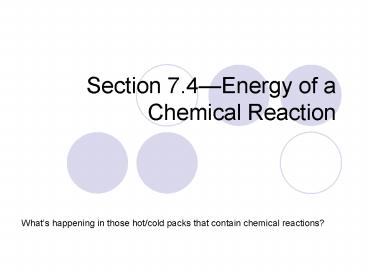Section 7.4 PowerPoint PPT Presentation
Title: Section 7.4
1
Section 7.4Energy of a Chemical Reaction
Whats happening in those hot/cold packs that
contain chemical reactions?
2
Enthalpy of Reaction
Enthalpy of Reaction (DHrxn) Net energy change
during a chemical reaction
DHrxn means energy is being added to the
systemendothermic -DHrxn means energy is being
released from the systemexothermic
3
Enthalpy of Formation
Enthalpy of Formation (Hf) Energy change when 1
mole of a compound is formed from elemental states
Heat of formation equations H2 (g)
½ O2 (g) ? H2O (g) C (s) O2
(g) ? CO2 (g)
A table with Enthalpy of Formation values can be
found in the Appendix of your text
Be sure to look up the correct state of
matter H2O (g) and H2O (l) have different Hf
values!
4
Enthalpy of Formation Enthalpy of Reaction
Breaking apart reactants is the opposite of
Enthalpy of Formation. Forming products is the
Enthalpy of Formation.
The overall enthalpy of reaction is the opposite
of Hf for the reactants and the Hf for the
products
Reactants are broken apart and Products are
formed.
This is not the way a reaction occursreactants
break apart and then rearrangeremember Collision
Theory from Chpt 2! But for when discussing
overall energy changes, this manner of thinking
is acceptable.
DHrxn sum of Hf of all products the sum of Hf
reactants
5
Example
Example Find the DHrxn for CH4 (g) 2 O2 (g)
? 2 H2O (g) CO2 (g)
Hf (kJ/mole) Hf (kJ/mole)
CH4 (g) -74.81
O2 (g) 0
H2O (g) -241.8
CO2 (g) -393.5
6
Example
Example Find the DHrxn for CH4 (g) 2 O2 (g)
? 2 H2O (g) CO2 (g)
Hf (kJ/mole) Hf (kJ/mole)
CH4 (g) -74.81
O2 (g) 0
H2O (g) -241.8
CO2 (g) -393.5
DHrxn -802.29 kJ
7
Lets Practice 1
Example Find the DHrxn for 2 CH3OH (l) 3 O2
(g) ? 2 CO2 (g) 4 H2O (l)
Hf (kJ/mole) Hf (kJ/mole)
CH3OH (l) -238.7
O2 (g) 0
H2O (l) -285.8
CO2 (g) -393.5
8
Lets Practice 1
Example Find the DHrxn for 2 CH3OH (l) 3 O2
(g) ? 2 CO2 (g) 4 H2O (l)
Hf (kJ/mole) Hf (kJ/mole)
CH3OH (l) -238.7
O2 (g) 0
H2O (l) -285.8
CO2 (g) -393.5
DHrxn -1453 kJ
9
Enthalpy Stoichiometry
- The Enthalpy of Reaction can be used along with
the molar ratio in the balanced chemical equation - This allows Enthalpy of Reaction to be used in
stoichiometry equalities
10
Example
Example If 1275 kJ is released, how many grams
of B2O3 is produced? B2H6 (g) 3 O2 (g) ? B2O3
(s) 2 H2O (g) DH -2035 kJ
11
Example
Example If 1275 kJ is released, how many grams
of B2O3 is produced? B2H6 (g) 3 O2 (g) ? B2O3
(s) 2 H2O (g) DH -2035 kJ
DH -1275 kJ (negative because its
released) From balanced equation -2035 kJ 1
mole B2O3 Molar mass 1 mole B2O3 69.62 g B2O3
-1275 kJ
1
g B2O3
69.62
mole B2O3
________ g B2O3
43.62
kJ
-2035
mole B2O3
1
12
Lets Practice 2
If you need to produce 47.8 g B2O3, how many
kilojoules will be released? B2H6 (g) 3 O2 (g)
? B2O3 (s) 2 H2O (g) DH -2035 kJ
13
Lets Practice 2
If you need to produce 47.8 g B2O3, how many
kilojoules will be released? B2H6 (g) 3 O2 (g)
? B2O3 (s) 2 H2O (g) DH -2035 kJ
From balanced equation -2035 kJ 1 mole
B2O3 Molar mass 1 mole B2O3 69.62 g B2O3
47.8 g B2O3
1
kJ
-2035
mole B2O3
________ kJ
-1397
g B2O3
69.92
mole B2O3
1

